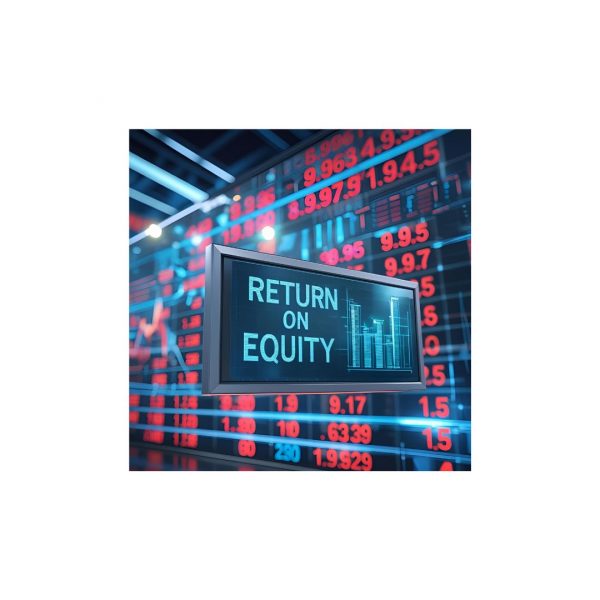Fundamental Analysis/5. ROE: The King of Profitability Ratios
Table of contents
Introduction: The Return on Your Capital
If there’s one number that the most expert investors, like Warren Buffett, pay particular attention to, it’s ROE, or Return on Equity. In our journey into fundamental analysis, we have already explored crucial indicators like the P/E Ratio, the PEG Ratio, and Market Capitalization (Market Cap), but this indicator doesn’t just tell you if a company is profitable; it answers an even more crucial question: “How good is it at growing the money that I, as a shareholder, have invested?” Return on Equity is useful for separating well-managed companies from those that destroy value.
The Key Indicator of Fundamental Analysis
Return on Equity represents the profitability of a company’s shareholder equity. In simple terms, it measures a company’s ability to generate a profit using the money invested by its shareholders.
The formula to calculate it is simple and intuitive:
ROE=Shareholder′s EquityNet Income
- Net Income: This is the company’s final profit—what remains after deducting all expenses, interest on debt, and taxes. In practice, it’s the money the company has truly “earned” over the course of a year.
- Shareholder’s Equity: This figure represents the value that belongs to the shareholders. It can be seen as the difference between all of a company’s assets and all of its liabilities (debts). Shareholder’s Equity is the capital that investors have put into the company, plus all the profits the company has generated and reinvested over time.
An Example: If a company has a Shareholder’s Equity of 1 million euros and generates a Net Income of 200,000 euros, its ROE will be 20%. This means that for every euro invested by shareholders, the company has generated 20 cents of profit.
Why is So Important? Three Key Reasons
- It Measures Management Efficiency: A high and consistent Return on Equity is a sign of exceptional management. It shows that executives not only know how to make profits but are also capable of allocating capital intelligently, reinvesting it to achieve ever-greater returns.
- It’s a Powerful Comparison Tool: ROE allows you to compare the profitability of different companies in the same sector, helping you identify the true leaders. For example, if you compare two banks and find that one has an 15% and the other has 8%, the first is generating almost double the profit with the same capital, making it a much more attractive investment.
- It Indicates Quality and Competitive Advantage (“Moat”): A company with a high and stable Return on Equity over time (for example, for 5-10 years) is not just efficient, but likely has a strong “competitive advantage” (in jargon, a “moat”). This means its position in the market is so strong that it can generate high profits without facing pressure from competitors.
What Are Good Values? And When to Be Careful
- A Good ROE: Generally, a double-digit ROE, above 15%, is considered a solid value. Market leaders in mature sectors often reach or exceed 20%. If a company can maintain a high ROE for many years, it’s a sign of exceptional quality.
- Warning Signs:
- Low or Declining ROE: An value consistently below 10% (or one that decreases year after year) is a sign of an inefficient business, a loss of competitive advantage, or a struggling sector.
- Negative ROE: A negative ROE means the company is incurring losses, eroding shareholder equity rather than growing it.
- ROE is Too High (the Trap): Be careful, however, of extremely high values. A very high ROE can be artificially inflated by high financial leverage (i.e., high debt).
Example: The ROE Trap with Alpha Tech and Beta Innova Let’s take two companies that generate the same net income, 200,000 euros. Alpha Tech has a solid Shareholder’s Equity of 1,000,000 euros and little debt. Its ROE is: $200,000 / 1,000,000 = 20%. This is an excellent value, showing efficient management and a robust balance sheet.
Beta Innova, on the other hand, has a huge debt, and its Shareholder’s Equity is only 200,000 euros. Its ROE is: $200,000 / 200,000 = 100%. At first glance, Beta Innova seems exceptional, but its very high ROE hides an enormous risk. Its profitability is due to massive debt, which makes it vulnerable in the event of a crisis or rising interest rates. This is a classic case of the “ROE trap” that can mislead less experienced investors.
Conclusion: Return on Equity as a Fundamental Piece of the Puzzle
In summary, ROE is a crucial indicator for measuring a company’s profitability and efficiency. It gives you an immediate view of how much value a company is capable of creating with the capital at its disposal.
However, like all fundamental analysis indicators, ROE should never be considered alone. You must always:
- Compare It with Competitors: An ROE of 12% might be low in the tech sector, but exceptional for a public utility company.
- Analyze the Debt: Check that a high ROE isn’t due to excessive financial leverage.
- Observe Growth: High is even more valuable if accompanied by consistent earnings growth.
By combining Return on Equity with the other indicators we’ve explored, you can build a complete and robust picture of a company’s value, making more conscious and informed investment decisions.






